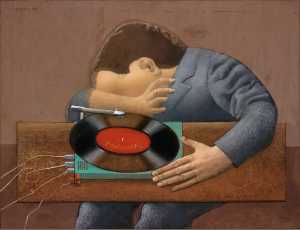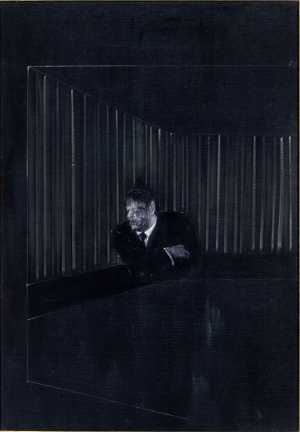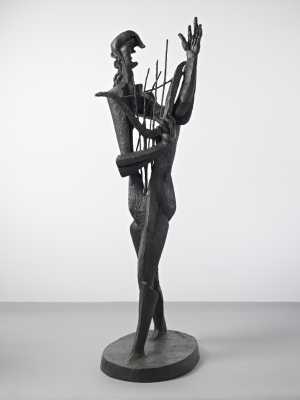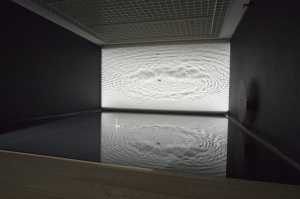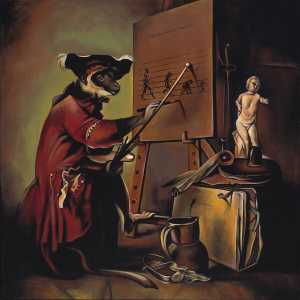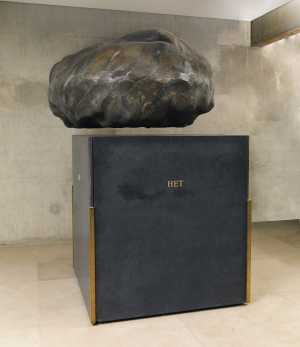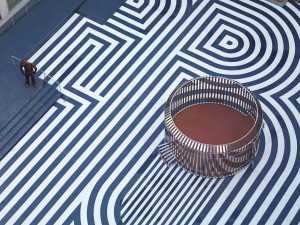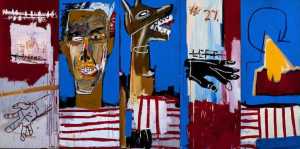'Danger de la Force' is a late work by Francis Picabia. In the last stage of his life, Picabia effortlessly painted both abstract and figurative works. After 1950 until his death in 1953, Picabia would hardly pick up a brush. He concentrated completely on writing poetry.

Specifications
| Title | Danger de la Force |
|---|---|
| Material and technique | Oil on canvas |
| Object type |
Painting
> Painting
> Two-dimensional object
> Art object
|
| Location | This object is in storage |
| Dimensions |
Height 114 cm Width 88 cm |
|---|---|
| Artists |
Artist:
Francis Picabia
|
| Accession number | 3404 (MK) |
| Credits | Purchase Stichting Fonds Willem van Rede. On permanent loan from the Cultural Heritage Agency of the Netherlands, 1999 |
| Department | Modern Art |
| Acquisition date | 1996 |
| Creation date | in 1947 - 1950 |
| Collector | Collector / W. van Rede |
| Provenance | Galerie Neuendorf, Frankfurt am Main; Geertjan Visser, Retie 1988-99 |
| Exhibitions | Brussels 1950; Marseille 1962; Rotterdam 1996a; Hamburg/Rotterdam 1997-98; Zurich/New York 2016-17 |
| External exhibitions |
Picabia: A Retrospective (2016) Picabia: A Retrospective (2016) Dal nulla al sogno (2018) A Surreal Shock. Masterpieces from Museum Boijmans Van Beuningen (2023) |
| Research |
Show research A dream collection - Surrealism in Museum Boijmans Van Beuningen |
| Literature | Camfield 1979, p. 292, fig. 409; Borràs 1985, cat. no. 930, fig. 1050; Hamburg/Rotterdam 1997-98, p. 135 |
| Material | |
| Object | |
| Geographical origin | France > Western Europe > Europe |
Entry catalogue A dream collection - Surrealism in Museum Boijmans Van Beuningen
Author: Marijke Peyser
Danger de la force is a late work by Francis Picabia. The composition is determined by a dynamic play of undulating vertical lines that move along round and amorphous forms. Lines and circles likewise make their presence felt in a number of his other paintings from that period. In December 1949 some of these late paintings were exhibited in Paris, in the Galerie des Deux-Îles and in 1950 in New York in the Rose Fried Gallery, along with a good deal of earlier work from his Dada period.[1] The works exhibited all had impasto backgrounds, often dark, and round forms in various colours and sizes.
The forty-plus paintings with circles in the Paris gallery provoked strong criticism. One critic from the art magazine Arts spoke of a ‘nice little device’ and added that circles on one canvas were acceptable, but were ‘exasperating when repeated endlessly with a pretentious weightiness’.[2] An American critic who saw the exhibition in Paris described the round forms as ‘points balanced on thick monochrome background … the pictures have all the monotony of astronomical photographs but none of their scientific interest’.[3] The rather crudely painted, simple compositions were seen as works by an artist who was mocking the viewer. There was criticism of the titles too: Sa pensée est l’ombre du soleil (Her Thought Is the Shadow of the Sun) and Tableau sans avenir (Painting Without Future) were not taken seriously.[4]
A more positive review entitled ‘The More Abstract the Better’ appeared in the American magazine Artnews. The well-known art critic Henry McBride, who saw the exhibition in New York, remarked that there were no paintings between Picabia’s Dadaist works and his recent canvases, so it was obvious that these recent paintings had to be interpreted as a return to his early Dada works.[5] The Belgian artist and art critic Michel Seuphor came to the same conclusion in the catalogue that accompanied the exhibition in Paris. Like McBride, he saw an end point in Picabia’s monochromes. For both of them it had come full circle: Picabia had rediscovered the essence of the Dada era, with the same grace and lightness. The essence of Dada? Dada is not a style. Dada does not mean anything. It was an anarchic attitude to life vis à vis the world in which the artist lived and worked. Picabia mocked and condemned bourgeois morality with his works in an often aggressive and absurd way. The late abstracts, in which the circle played such a dominant role, were a fascinating end point in the oeuvre of an extremely shrewd artist.[6]
Footnotes
[1] Camfield 1979, p. 273.
[2] Anonymous, ‘Francis Picabia, un point c’est tout’, Arts, 23 December 1949, quoted in Hamburg/Rotterdam 1997-98, p. 29.
[3] Anonymous, ‘Old Trickster’, Time, 10 April 1950, p. 66, quoted in ibid., p. 31, note 30.
[4] Camfield 1979, p. 273.
[5] Hamburg/Rotterdam 1997-98, p. 31, note 30.
[6] For an overview of Picabia’s many style developments, see Zurich/New York 2016.
All about the artist
Francis Picabia
Parijs 1879 - Parijs 1953
Early in his career, Francis Picabia experimented with a variety of styles, including Impressionism and Cubism. In 1911, he met Marcel Duchamp, who had an...
Bekijk het volledige profiel


